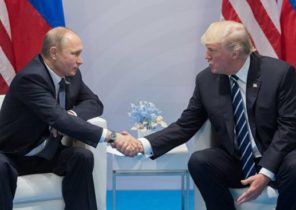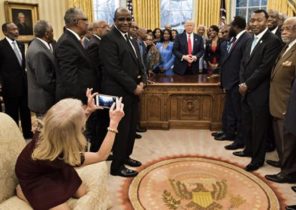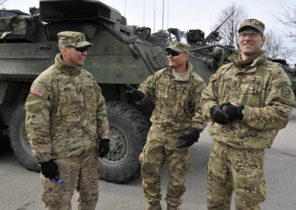
Today, when Australians start to think about the alarming issues of nuclear weapons, they primarily pay attention on the missile and nuclear programs that it is dangerous rapidly implements North Korea, to strengthen the role of nuclear coercion in the Russian strategic policy on new nuclear challenges in Asia and the long-term prospects for nuclear proliferation in the middle East. But there is another issue that requires our attention. We are talking about the concept of nuclear balance between the great powers in the early twenty-first century.
It has been over a quarter of a century since, when the Australians drew attention to the balance of power. With the end of the cold war, Australian strategists and thinkers is not very concerned about the so-called granularity, nuclear balance, such as comparative variants-based, throw-orbit mass and the pace of modernization.
Meanwhile, we focus on the relationship with other nuclear powers — in particular, on the characteristics of exclusively asymmetrical nuclear forces. This means that we forget some important lessons of the cold war that nuclear equilibrium is the result of human effort and not natural phenomenon that this equilibrium is not static and over time changes the composition of the Arsenal are no less important than its size (see below), and that American allies feel anxiety, when the U.S. nuclear Arsenal seem weaker than the arsenals of authoritarian great powers of the number of rivals of America.
I have a suspicion that we are entering into a new phase in the nuclear relationship between the great powers, but repeat these lessons. Despite the recent increased media interest in the possibility of a new nuclear arms race between the US and Russia, in this new phase, the real race is unlikely to start. Most likely, we are entering the era of the controversial modernization carried out by the US and Russia. I don’t want to simplify what is happening: this is still a rivalry, which is the basis of the future nuclear balance between two powers.
Stable nuclear balance is a balance, in which none of the parties are not having the urge to press the button first. Usually important here is not just the size of Arsenal, but his form. Take as an example the agreement on arms control between the two superpowers, resulting in restriction of accountable nuclear warheads to one thousand units. (I say “identifiable” because the number of warheads typically depends on the agreed counting rules on specific means of delivery.) Say, country a decides to place a 300 Intercontinental ballistic missiles with one warhead in stationary silos, 600 nuclear warheads on missiles with multiple warheads in the sea and 100 warheads aboard strategic bombers, long-range. And country B decides to build a 100 Intercontinental ballistic missiles with 10 warheads each, and place them in stationary silos.
Even a blind man will see that the difference in the configuration of the two arsenals are very much destabilizie nuclear balance. Country B should be the first to make a start — for the simple reason that its entire Arsenal vulnerable to enemy attack with the use of a total of 200 warheads (two warheads on each of the 100 stationary mines). And both sides know it.
Now let’s look at another scenario. The country And the Arsenal is the same as described above. Country B deploys only 50 of its 100 ICBMs with 10 warheads, but then begins to reproduce the actions of the country And placing 400 warheads on their submarines and 100 nuclear warheads on bombers. Hands up all those who think that it is better. Well, the way it is, but the improvement is insignificant. Country B has kept a large force of the first blow, but has created a more reliable power for a second strike to support them. With such a structure, nuclear forces, country B should still strike first. This second scenario is quite well known, because in General it has to be like the Russian-American balance currently.
In this second scenario, the vulnerability of heavy ICBMs is still the basis of the problem of balance. To strengthen the stability only in the case that country B will significantly reduce the rate of deployment of ICBMs with multiple warheads of individual guidance, and their throw-weight.
Now consider this problem in the framework of modernization. In the United States is currently a debate about the modernization of Intercontinental ballistic missiles. Over the years, these rockets have lost multiple warheads, and now they have only one warhead. Yes, they are vulnerable to enemy attack because they are in a stationary mine installations. But any attack will cost the aggressor, because to destroy the mine with a single warhead he will need two warheads. Moreover, the enemy will have to direct missiles at targets located on the territory of the United States, and is a serious step towards escalation during a nuclear conflict.
Meanwhile, Russia is modernizing its nuclear forces and replaces (but does not remove weapons) heavy ICBM “Voevoda” with ten warheads. The creation of a new ICBM RS-28 “Sarmat” was established in October 2016. It is still under development and may be launched not earlier than 2018. They say that it is able to deliver the target of 10 more powerful warheads, or 16 warheads with smaller capacity, or a combination of warheads and means of achieving breakthrough ABOUT that enable you to successfully strike due to the increase of protective properties of a missile. RS-28 is too big to be hide, too heavy to carry and too important to the enemy could ignore it. It will be a significant factor, driving us in the second above-described scenario. In such a scenario, Russia will continue to deploy heavy ICBMs, which constitute a significant portion of its nuclear Arsenal significantly and destabilisateur the situation regardless of what decisions will be made by the new us administration.







